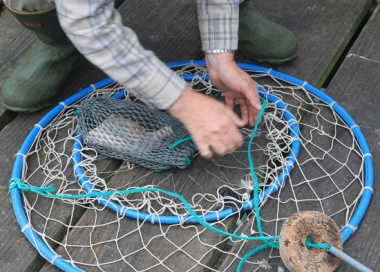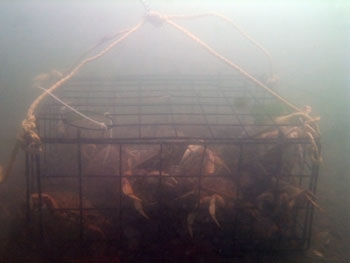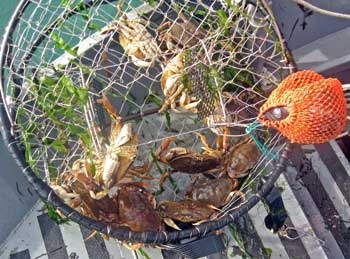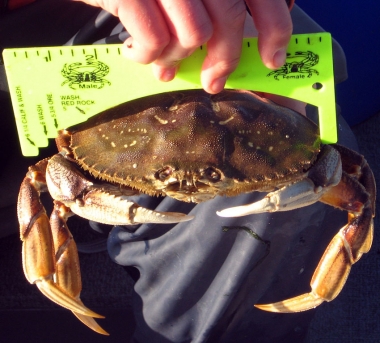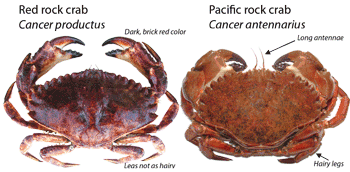
How to crab
Oregon crabbing is a year-round activity that can almost always yield a successful trip. Crabbing trips require minimal gear, often available for rent in coastal towns, and while boat crabbing increases your likelihood for success, dockside crabbing is easy and very accessible. Before crabbing, be aware of crab regulations. Knowledge of where, when, and how to crab will increase your chances for success.

It is always good practice to review shellfishing regulations before you head out crabbing. Check out the current regulations online or pick-up a current Oregon Sport Fishing Regulation booklet at any ODFW office or sporting goods store.
When to go
You can find some crab in every Oregon estuary, but Tillamook, Yaquina and Coos normally provide the best year-round opportunities.
Time of year
Smaller estuaries and those with more fresh water influence may be good during the late summer through the early winter. Fall is typically the best time to crab. Beginning in September, crabs will tend to be more “filled out," meaning there is a higher percentage of quality meat. You can tell meat quality by the condition of the shell. Hard-shelled crabs will contain 20-30 percent meat by weight, compared to soft-shelled crabs which can be as low as 12 percent meat. After heavy rainfall and resulting freshets, crab tend to be less abundant in the bays.
Time of day
“Slack water” (the times of peak high or low tide) are the best times to crab. During swift tidal exchanges crab often bury themselves, but at slack water more crab are walking around foraging, since they are being less affected by tidal currents.
Legal season
Crabbing is open in estuaries (i.e., bays), beaches, tide pools, piers and jetties year-round. Crabbing in the ocean is CLOSED for crab from Oct. 16 through Nov. 30.
Going crabbing
- Call the Shellfish Safety Hotline at 1-800-448-2474 or visit ODA website before harvesting and consuming any shellfish.
- Make sure you have your shellfish license, crab measuring device, pots or rings, cooler, bait holders and bait.
- Check all the lines on your crab pots or rings for kinks or knots to ensure they are durable and will allow gear to work correctly.
- Recreational crabbers are not required to mark their line but are prohibited from using certain line markings that are required in other fisheries. To read more about why and what is prohibited, visit our Marine Life Entanglement page.
- Make sure all your buoys are well-marked per regulations so you can tell which pots are yours.
Baiting your gear
Many different types of meat are used for crab baits: turkey, chicken, mink, fish carcass, shad, herring, clams, etc… But whatever you use, fresh bait is best.
- There are many ways to secure your crab bait. As long as the bait stays in the gear when crabbing, and the crabs can get to it, most methods will work.
- Keep in mind that seals and sea lions will eat any attractive bait that they can get -- including bait laying out on a crab ring. You can avoid this problem by using a bait bag, using bait that they don’t eat (e.g., turkey legs) and avoiding areas where they are prevalent.
Setting your gear and soak time
From a boat:
- Remember to set your crab gear outside of navigational channels.
- Set pots far enough apart so that you aren’t competing with your own gear.
- Try to allow 30-60 minutes before retrieving your gear if you are crabbing with pots and 10-15 minutes if you are crabbing with rings.
From a dock:
- Tie the end of your crab line to the dock or pier from where you are crabbing.
- Throw your crab pot or ring in the water to start crabbing.
- Try to allow 30-60 minutes before retrieving your gear if you are crabbing with crab pots and 10-15 minutes if you are crabbing with rings.
Retrieving your gear
From a boat:
- Locate your buoy and approach slowly along the side of the boat.
- Grab the crab line just below the buoy with your hand or a gaff.
- A "crab davit" makes retrieval much easier on your back.
- When using crab rings, be sure to pull quickly at first to get the ring into a basket shape so you don't lose the crab.
From a dock:
- Grab your crab line below where you have attached it to the dock or pier and pull your crab ring or pot to the surface.
- If you're using crab rings, remember to retrieve at a consistent speed in order to keep the sides of the ring over the crabs to avoid losing any.
Sorting crab
Quickly sort through crab, being careful to not break crab legs or get your fingers pinched.
- Be extra cautious when reaching into a pot or ring full of crab. Handle the crab from the rear with a thumb on the underside or by grasping the rear legs.
- Be sure to carefully and quickly release unwanted crab; do not drop them from high docks or piers, as this may crack their shell and kill them.
- Keep only male Dungeness crab (see the difference here)
- Once harvested, European green crab may not be returned to the water.
Measuring crab
- Measure all male crab with a crab gauge. Legal Dungeness crab must be male and at least 5 ¾ inches across the back (NOT including the spines) or wider.
- When measuring make sure you measure in a straight line across the back immediately in front of, but NOT including the last points.
- Measurement points
Keeping crab quality
- Store legal-size “keeper” crabs in a cooler with ice or ice packs, or in a bucket or cooler with water.
- If you keep your crabs in a bucket or cooler with water, make sure to change the water frequently to keep the water cool and ensure they don't run out of oxygen in the water.
- Releasing “soft shell” crab is strongly recommended. Soft shelled crab are newly molted and are essentially a small crab in a big crab's body. Meat pick out can be very low (as little as half that of a crab in good condition) and the quality of the meat is usually stringy and not as delicious.
Commonly caught crab species
Dungeness crab
About: Adult Dungeness crab forage on a number of fish and invertebrate species. They are relatively short lived crustaceans with a maximum life expectancy of about 10 years. Every spring, female Dungeness molt, which attracts male crabs to both mate with and protect them while their shells are soft. Males molt in the late summer. Since the males do not have a protector while their shells are soft, they generally bury themselves in the sand, making them more difficult to attract to crab pots.
Habitat: They can be found throughout the sandy and muddy areas in the shallowest parts of lower estuaries all the way to ocean depths of 2,000 feet.
Best identification characters:
- White tipped claws
- Ten carapace spines (widest at 10th)
- Color reddish-brown to purple
Red rock crab
About: People often mistakenly think that red rock crabs are non-native but red rock crabs are in fact a native species found in the fossil record, as well as in Native American middens. They are an important component of Oregon estuaries and nearshore areas, and even help estuary ecosystems by eating invasive species such as green crab.
Habitat: As the name implies, red rock crab prefer the harder substrate habitats such as rocks, pilings and other structure. Red rock crab prefer higher salinities than Dungeness crab and therefore are usually found in larger estuaries, close to the ocean. They are most common in Tillamook, Yaquina and Coos bays where there is plentiful rocky substrates.
Best identification characters:
- Black tipped claws
- Wide “fan” shaped carapace
- Color typically a deep brick red
A similar relative: The Pacific rock crab inhabits similar habitats as the red rock crab, however is more often found in the nearshore ocean. Occasionally, these crab are caught in the bay. They are easily discerned from red rock crab by their spotted undersides, brown/ purple color, and hairier legs. Its species name “antennarius” is Latin meaning “antennae,” referring to the noticeable longer antennae when compared to other cancer crabs.


